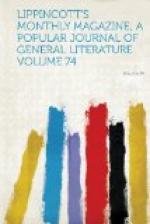There are a great variety of charming drives and walks in the neighborhood in every direction; and the whole district is full of the villas and well-kept gardens of the rich Milanese, who have chosen this favored spot for their country residences. I have said well-kept gardens advisedly; and it is worth noting that the love of gardens and gardening seems to be a specialty of the Milanese among all the Italians. One sees in other parts of Italy the remains of care and magnificence of this sort—at Rome especially; but all (though in many cases belonging to owners still wealthy as well as noble) dilapidated, little cared for, and speaking in melancholy tones of decay and perished splendor. A ruined building may be an extremely picturesque object, but a ruined garden can never be other than a melancholy and repulsive one. But the whole of this district testifies to the love of the Milanese for their gardens; and most of them are on a truly princely scale of magnificence. There is one villa which I will mention, because the owner of it is doing there what recalls to our minds strikingly the old days which saw the creation of that Italian splendor the remains of which we still admire, and suggests that it is not beyond hope that the privileged soil of Italy and the genius for the arts which seems inherent in this people may, under their new political circumstances, lead to yet another renaissance. The villa I am alluding to is in the immediate neighborhood of Varese, on a rising ground above the town, commanding the most magnificent views of Monte Rosa, Monte Viso and the country between the lakes of Como and Maggiore. It is a new creation, and is the property and the work of the Milanese banker, Signor Ponti. The house and gardens are well worth a visit—if the traveler is fortunate enough to be permitted to see them—for the sake of the happy originality of idea which has inspired the architecture of the former and the excellent taste which has turned the favorable circumstances of the ground to the best account in laying out the latter. But the feature which I specially wished to mention is the ornamentation of the principal salon or ball-room in the villa. When permitted to visit it we found Signor




